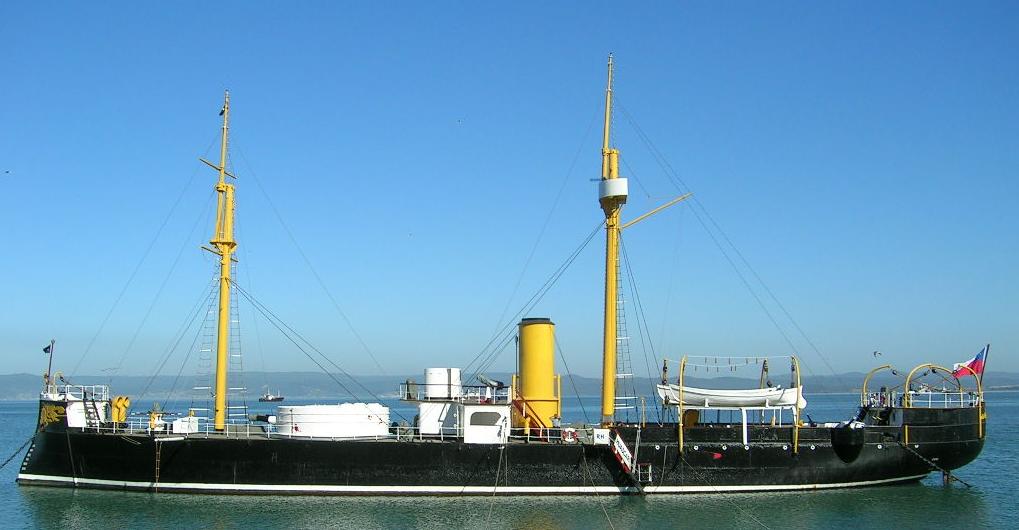
Huáscar (1865)
 Peruvian Ironclad (1864-79) Chilean ironclad (1879-94), museum ship since 1934
Peruvian Ironclad (1864-79) Chilean ironclad (1879-94), museum ship since 1934
The first American turret ironclad

The legendary battle of Angamos between Huascar and Esmeralda
BAP Huáscar was the first sea going turret ironclad in the Americas, a true naval landmark. Until then (she was started on 4 August 1864 at Laird Bros. in UK as the US civil war raged on), only Monitors used turrets. Chile at the time was at odds with its neighbours, and in context of the ongoing naval races she became flagship of the Peruvian Navy. At the time only the Royal Navy had such turret ships HMS Royal Sovereign (launched 1857, modified and completed 1864) and HMS Prince Albert (launched 1864). This was certainly the first export of the kind. Huáscar had a strong naval record, several battles and campaigns, but was eventually captured by Chile. She is also the only one of her kind still preserved to this day. #huascar #peruviannavy #ironclad #1865 #colesturret #battleangamos #almirantegrau
Huáscar was commissioned 8 November 1866 after a period of rapid expansion of the Peruvian Navy. She saw plenty of action at the Battle of Pacocha and in the War of the Pacific of (1879–1883), until capture by Chile at the Battle of Angamos on 8 October 1879. Changing hands, she served without much incidents and the same name until 1897 when decommissioned (she had been upgraded and modernized in between). Fortunately, she was preserved in 1834, after spending years as a utilitarian hulk. Today Huáscar is one of the only surviving ironclads with HMS Warrior, restored in her original 1870s appearance, and now a memorial ship anchored in Talcahuano in Chile.
A bit of context: The Peruvian Navy in 1865
Peru gained independence from the Spanish Empire in 1824 after a long struggle from 1809. In the 1860s, the economics of Peru were on the green, thanks notably to a rapid expansion of local exports and the birth of industry. Long story short, the beginnings of the Republic were marked by Spanish resistance, the Bolivarian era, Conflict with Bolivia and Colombia and instability, then from 1836 the Peru-Bolivian Confederation wirth the 1839 Restoration, a period of Military anarchy in 1841–1845, the “fallacious prosperity” and the Guano Era in 1845–1866 and in between the 1854 Liberal Revolution, 1857 Ecuadorian–Peruvian War and subsequent War with Spain.
The early Peruvian Navy 1821-1860
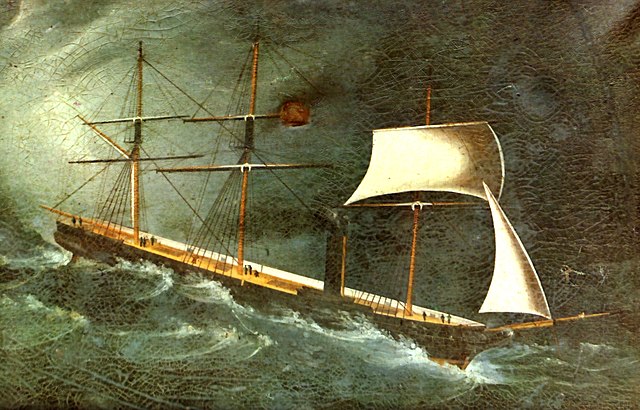
BAP Amazonas
Despite this context, the Peruvian Navy (Marina de Guerra del Perú), was founded by general José de San Martín on 8 October 1821 but stayed fairly small. It took part in the War of Independence (1821–1824) only using captured Spanish warships and deploying on land a Naval Infantry which illusrated themselves in many actipons, notably by taking the Spanish-held city of Arica. This navy also took part in the Gran Colombia (1828–1829) was, blockading Guayaquil, assisting Peruvian occupation, and then as part of the Peru-Bolivian Confederacy (1836–1839) and the Chincha Islands War with Spain. At the time, outside former catpured vessels, the “flagship” was Aurimac, a 1850s screw frigate with 34 guns, probably acquired in 1862.
The 1864 naval plan
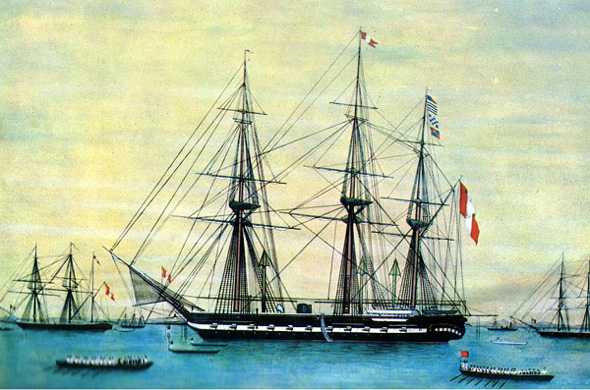
The 1855 Frigate Apurimac
In 1864 an ambitious naval program was launched, largely funded by the commerce of Guano with Europe. There were two new constructions: The Central Battery ship Independencia buiult in Samuda Bros.
with 18 guns, launched in August 1865, and the more ambitious turret ship Huascar, launched two months afterwards, and ordered at Laird Bros. It was completed by the acquisition in 1965 of the former steam corvette CSS Texas (built in France for the Confederacy), resold as “America” to Peru as well as the steam corvette CSS Georgia, renamed “Union”. In 1866 was acquired from the Union, the former monitor USS Catawba, purchased and renamed Atahualpa and completing Huascar as the second turret ship of the Peruvian Navy, giving it a crucial advantage over its rivals during the Pacific war.
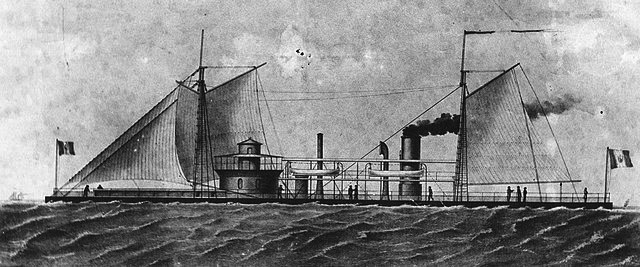
The monitor Atahualpa, ex USS Catawba
The War of the Pacific (1879–1883) caught the Peruvian Navy still unprepared however, with inferior naval forces at least in numbers compared to the Chilean Navy. Even so, led by war hero and Peruvian Admiral Miguel Grau, hit-and-run tactics based around Huáscar famously delayed the Chilean advance by six months until her demise at the Battle of Angamos. Huascar was captured, Independencia was destroyed in May 1879, Atahualpa was scuttled in Callaso in 1881, at the time of a second naval plan was launched to acquire two cruisers (The Lima class, launched in Germany, 1880) and two torpedo boats of the 1879 Herreschoff type. The full historical context of the Peruvian Navy is expected in 2023.
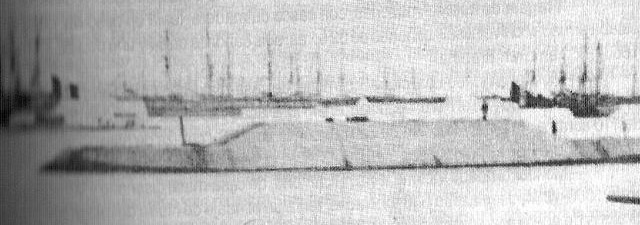
BAP Loa after conversion as a monitor.
Design of the Huascar
Development context
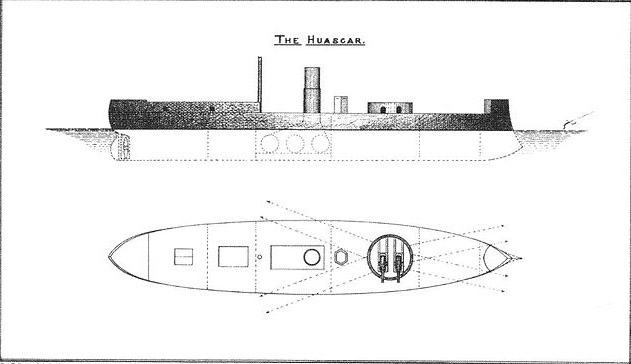
Initial plans at Laird Brothers. The latter were recoignised for their expertise in rams.
In 1864, Peru was in a delicate diplomatic situation with Spain later leading to the Spanish-South American war. It was realized at the time, the small Peruvian Navy lacked firepower to compete with the armada, and these exceptiopnal cicumstances motivated Juan Antonio Pezet to send a commission in UK to seek after new warships to reinforce the Chilean battle squadron.
On August 12, 1864, the contract for the construction of a new, innovative warship after a suggestion of naval attaché there to contact Coles, was signed in Birkenhead between future captain José María Salcedo, on behalf of the Peruvian government, and Laird & Brothers shipyard for 71,000 £ without artillery, which brought the total to 81,247 £ and 12 months of construction.

General appearance. See also a 3d reconstruction
The shipyard assigned the new ship, construction number 321 and it was designed by Captain Cowper Phipps Coles, who incorporated a number of innovative features, notably his trademark turret, plus many technological advances for the time to face the Spaniards. Her propulsion machinery and boilers were provided by Penn and Sons, artillery came from Armstrong. She was launched on October 7, 1865, baptised Huáscar in reference to the penultimate Inca Emperor, son of the Inca Huayna Cápac.
Hull and general design
Main dimensions of Huáscar were modest: 59.4 m (195 ft) overall in lenght for 10.6 m (34 ft) in beam and 4.5 m (14 ft) in draft. She displaced 1,100 tonnes light or standard, and 1,745 t at full load.
The hull was made in riveted iron and subdivided divided longitudinally into five watertight compartments defined by four 15 mm (5/8 in) thick bulkheads. She had a main deck 1.37 m (4.5 ft) above the waterline (full loaded) and a low profile not well suited for harsh weather conditions, and a second deck 2.5 m below it.
Huáscar’s prow had a spur and a customary decoration up. Her stern was well shaped, clipper style and she was generally considered “very manoeuvrable” by the standards of the time. She could notably made a 180° turn in 2 minutes.

Huascar’s lower deck wheelhouse
Her superstructure comprised the forecastle and foremast, then the main artillery Coles turret, hexagonal-shaped conning tower, telescopic funnel (8 meters high when deployed), which can be dfolded down to reduce drag when sailing, the main mast aft and sterncastle. To deal with heavy seas, the main deck had retractable metal skirtings, folded down to free the turret’s sight. Huáscar has two steering control rooms, the main one was located on the main deck forward, in to the unprotected sterncastle while the combat steering room was deeper in the second deck under the conning tower. Officers’ accommodations were aft, in the second deck aft while the rest of the was in the second deck, forward of the artillery tower, which was customary at the time. The galley was located aft of the combat control room in the second deck.

Captain Grau’s cabin, restored in her original state
Armour protection layout
Huáscar was protected by side armor made of hardened iron:
-Belt: 114.3 mm (4.50 in) thick amidships, tapering down to 63.5 mm (2.50 in) fore and aft
-Belt extended below waterline to 1 m (3′ 3″).
-Intermediate hull/armor teak lining 254 mm (10 in) thick acting as cushion.
-Main deck 50 mm (1.97 in) thick plating.
-Main turret 139.7 mm (5.50 inches), reinforced close to embrasures with 177.8 mm (7 inches) plates
-The main turret was bolted to a metal frame 330.2 mm (13 in) thick teak interior lining.
-The conning tower had 3.00 in (76.2 mm) thick armor backed by 8.00 in (203.2 mm) teak.
Powerplant
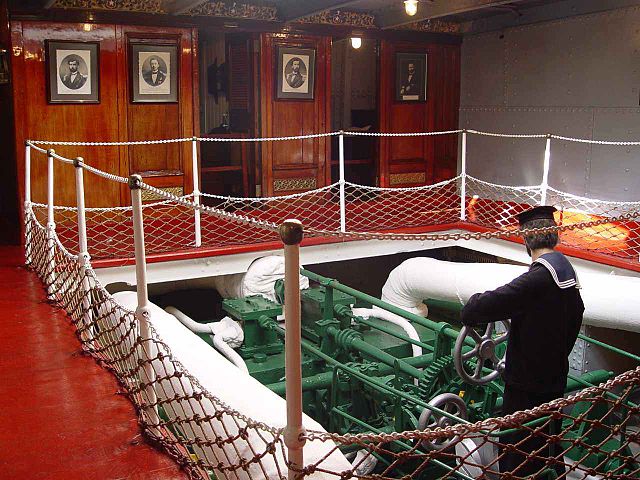
Huascar’s propulsion system revolved around her steam engine, Maudslay type, horizontal and two-cylinder, two-stroke. Each cylinder has a 1.37 m (54 in) bore, 914.4 mm (3 ft) stroke, generating 1.23 MW (1,650 HP) at 78 revolutions per minute. Each cylinder discharged to independent condensers, in which it mixed with seawater, producing condensation. This enabled to reduce feedwater loss, consumed from the double bottom tanks. This vacuum came from a air pump located immediately below the condenser, actuated by a rod coupled to the piston. Four trunk pumps driven by eccentrics were also connected to the crankshaft, and there were salt water pumps for the condenser, and two bilge pumps.
The boiler department was a single room with four horizontal boilers, two with four funaces, two with three furnaces, working at 172.3 kPa (25 psi). Coal feeding was ensured by a multi-purpose machine in the same room.

Original Coles plan, showing her internals
This steam engine drove a single four-bladed propeller 4.49 m (14 ft 9 in) in diameter. This allowed Huascar to reach 12.25 knots on her maiden sea trial, without guns or load and just 100 tons of coal.
Huascar was also fully rigged: This consisted of a brigantine-type rig, on two masts with tripod-shaped ratchet derived from Coles patent than can be quickly dismounted in combat, clearing the main guns’s view all around. In June 1879, however, before the first engagement, Captain Grau removed this system in Callao permanently.
Armament
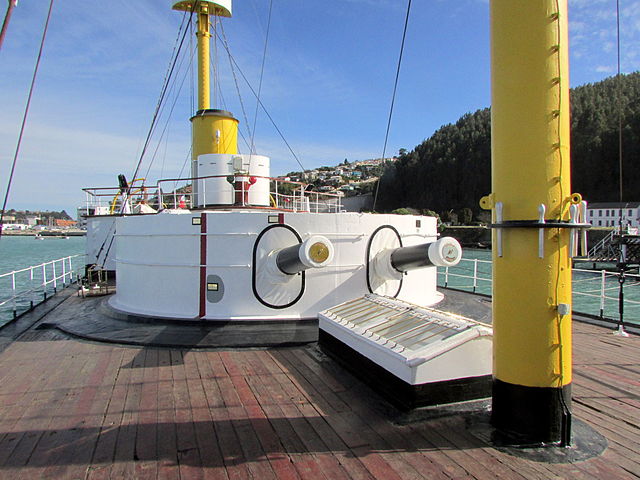
Main
The main armament of Huáscar was in the single, large Coles rotating turret located on the main deck, between the forecastle and conning tower. Cylindrical and 6.7 m (22 ft) in diameter, this turret weighted 37 tons, sitting on a platform on top of a spine located further in the hull, straight to the bottom. The main rotation on deck was ensured by a roller bearing located on the second deck, consolidated by the fixed guide axis in an inkwell bolted to the keel. Traverse was manual, required 16 men and 15 minutes for a 360°. The forecastle being taller than the guns, their traverse was limited to 138° per side with blind angles 64° aft and 20° forward.
As designed, she carried two Armstrong guns. These were muzzle-loading, rifled models which barely protruded from the turret, 12.5 tons each. Their caliber was caliber 254 mm (10 inches). They fired 136 kg (300 lbs.) hardened shells with the Palliser armor-piercing model which was made standard on Chilean vessels, but never arrived on time before the battle of Angamos. They certainly would have changed the balance.
Secondary
Huáscar also was fitted with two 120 mm (5 in) Armstrong rifled guns located port and starboard. They fired 18 kg (40 lb) shells. No data is available about their detailed specs.
-This was completed by a smaller Armstrong 76 mm (3 in) rifled gun at the poop, firing 5.5 kg (12 lb) shells, aft, located in a porthole and acting as chase gun.
-Prior to the Pacific War, it was decided to add a single 11 mm Gatling machine gun (0.44 in) on top of the mainmast to “clean up” enemy’s decks if needed.
⚙ Huascar specifications |
|
| Displacement | 1870 – 1900 tonnes |
| Dimensions | 66.9 x 10.9 x 5.7m (219 x 36 x 19 feets) |
| Propulsion | 1 shaft Maudslay HRCR*, 4 boilers, 1,650 ihp (1,230 kW), Brig sail |
| Speed | 12 knots (22 km/h; 14 mph) |
| Range | Unknown |
| Armament | 1×2 10-in, 2× 4.7-inc, 1× 12-pdr, 1 Gatling gun, ram |
| Protection | Belt 4.5 in, Main turret 7.5 in, CT 3 in, Deck 2 in |
| Crew | 170 |
*Horizontal-return connecting rod-steam engine
In the naval press of the time
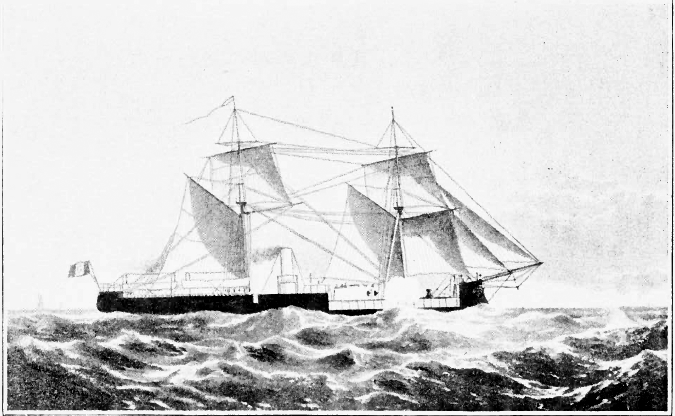
A drawing of Huascar with her brig-rigged sails
Captain Cowper Coles, wrote of Huáscar: “…as a sea-going vessel of 1,100 tons, 300-horse power, and a speed of 12 1/4 knots. Her foremast is fitted with tripods; she carries two 300-pounders in one turret.” And “…the “Huascar” class of 1865 fitted with a hurricane deck; she was one of six different classes designed and built by Messrs. Laird Brothers, to whom the credit for their great success is due. She can fire right ahead from her 300-pounders, and aft within 15 degrees of the line of keel, but would have a stern chaser either on or under her poop.”
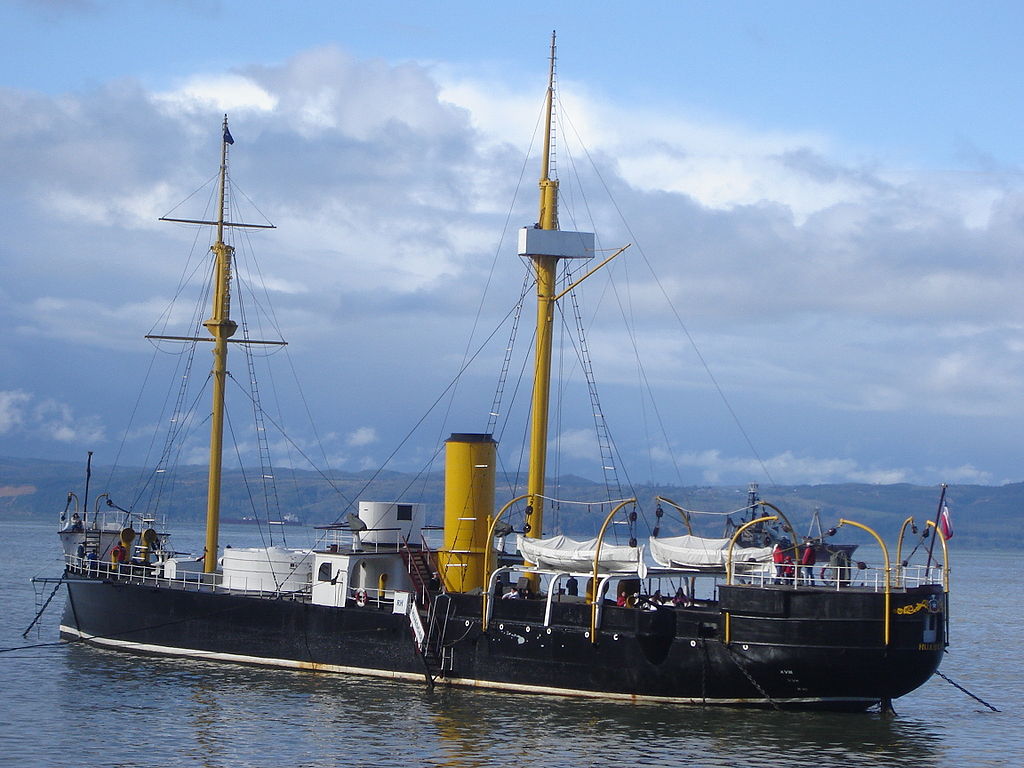
The British magazine Engineering described it: “She is an armour-clad monitor built by Messrs. Laird Brothers, of Birkenhead, in 1866…… She is 190 ft. in length between perpendiculars, 35 ft. in extreme breadth, and 19 ft. 9 in. in depth of hold. Her builder’s tonnage is 1101, and indicated horse power 1500. Her draught of water is 15 ft. 6 in., and her maximum speed is said to be 12 knots when her boilers are in good condition, and the bottom is clean. Her usual speed under good working conditions is probably not more than 10 1/2 to 11 knots. She is propelled by a single screw. The Huascar is a rigged two-masted vessel, the foremast being upon Captain Cole’s tripod principle. Her freeboard, or height of deck above water, is about 5 ft. She carries two 300-pounder Armstrong guns in one turret, which is protected by 5 1/2-in. armour plating upon a teak backing of 14 in. The sides are protected by armour plating 4 1/2 in. thick amidships, tapering to 2 1/2 in. at the extremities, which is also worked upon a teak backing of 14 in. There is an armoured pilot tower of hexagonal form abaft the turret from which the ship is worked in action; and the openings in the deck are protected by 2-in. iron plates that are shipped in the openings for skylights or hatchways. The Huascar is an iron-built vessel, and at the time she was built was most perfect in all the appliances of defence, and in her internal arrangements.”
Career in Peruvian Navy
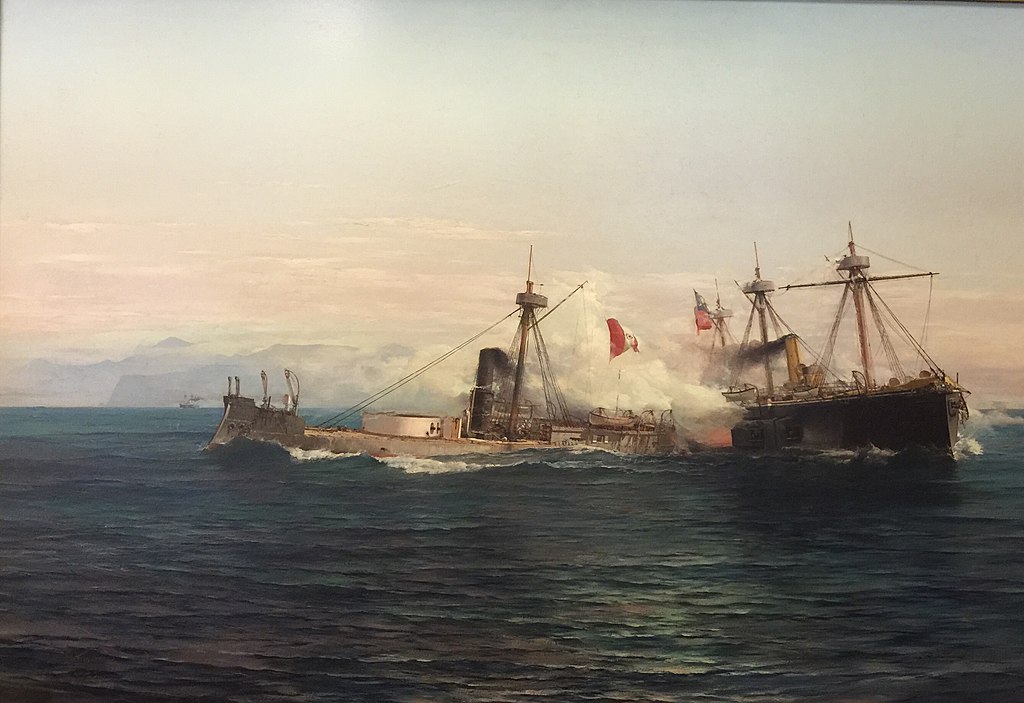
Huascar at the battle of Angamos, one of the most fiercely contested industrial era duel at sea, a legendary fight worthy of a movie
Early Years
Huascar was commissioned, Commanded by bi-national Peruvian-Chilean Captain José María Salcedo. He was a naval officer in service of the Peruvian government, surveying the construction on behalf of the Peruvian Navy, leaving the channel on complicated trip, starting on 20 January 1866. Due to bad weather, he had to wait a month at Brest, France, then had a minor collision with the also British-built ironclad Independencia on 28 February. Due to refusal by neutral countries back in South America, she spent a further month for repairs at Rio de Janeiro. Salcedo also had to deal with the insubordination by Independencia’s commander, and managed to capture and sink the Spanish brigantine Manuel en route, even before stating official service. She finally arrived in port at Ancud, in allied Chile, joining the rest of the combined fleet on 7 June but too late to take part in the war with Spain.
Later, under Captain Lizardo Montero, Huáscar was sent to Valparaíso in order to take part in a late 1866 expedition against the Spanish fleet in the Philippines. However Montero and other Peruvian officers objected Rear Admiral John R. Tucker’s plans (he was “loaned” by the Govt. as a former Confederate officer). Unable to command the fleet he requested to be relieved. Captain Salcedo took back both his position and the command of Huáscar and the expedition was cancelled.
In February 1868, Miguel Grau took command of Huáscar in turn. Her would remain in command until 1876, as her longest-serving commander (and a superstar here). His long stay on board, also due to the unconditional love of its crew, managed to produce a finely tuned ship, the best of the Chilean Navy, and Grau was to become Peru’s most renowned naval officer.
Peruvian Civil War: The Battle of Pacocha
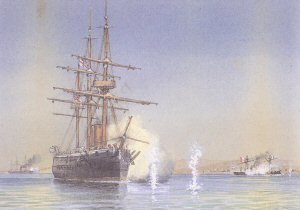 Huáscar then took part in Nicolás de Piérola’s 1877 attempt to overthrow the Peruvian government. On 6 May, two of de Piérola’s supporters, Colonel Lorranaga and Major Echenique, went on Huáscar at Callao while the captain and executive officer where ashore, trying to take command. Some of the officers on board however proved part of the plot, persuading the crew to join their cause. The now “rebel” Huáscar departed with Luis Germán Astete in command. They wanted Atahualpa to follow them, but the old ship was in such a state she had to turn down. From then on, Huáscar started to harass and disrupt government forces and its shipping lanes, preying so much on shipping eventually, the British, which depended in part on Peruvian goods, intervened in force.
Huáscar then took part in Nicolás de Piérola’s 1877 attempt to overthrow the Peruvian government. On 6 May, two of de Piérola’s supporters, Colonel Lorranaga and Major Echenique, went on Huáscar at Callao while the captain and executive officer where ashore, trying to take command. Some of the officers on board however proved part of the plot, persuading the crew to join their cause. The now “rebel” Huáscar departed with Luis Germán Astete in command. They wanted Atahualpa to follow them, but the old ship was in such a state she had to turn down. From then on, Huáscar started to harass and disrupt government forces and its shipping lanes, preying so much on shipping eventually, the British, which depended in part on Peruvian goods, intervened in force.
On 29 May, Huáscar took part in the Battle of Pacocha against two British vessels, the frigate HMS Shah and the corvette HMS Amethyst, (Admiral Algernon Frederick Rous de Horsey), HMS Shaha using a torpedo for the first time. This proved enough as the rebel turret ship surrendered to the British, and behind, legegitimate Peruvian government, after a month of rampage.
War of the Pacific: Iquique and Angamos
Huáscar then back in Grau’s hands, and after some sacking of officers and dismissal of some in the crew, she took part in the War of the Pacific (1879–1883). Thus episode is long and would need a fully fledge article of its own, but anyway, Huascar started a serie of daring harassment raids on Chilean ports and transports. These standalone actions managed to delay the ground invasion for almost six months, until the Chilean fleet could muster enough forces to track, corner and and stop Huáscar.
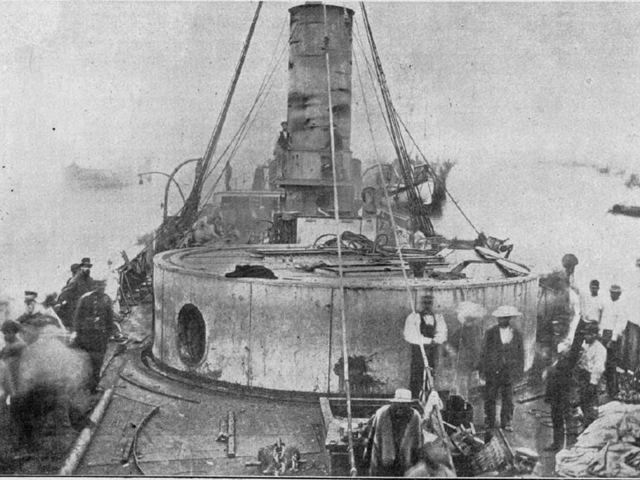
In Valparaiso, 1879
On 21 May 1879, Huáscar was falling on the Chilean Navy responsible for the blockade of Iquique. This led to the Battle of Iquique, in which an equally famous captain, onboard the corvette Esmeralda, Arturo Prat, was killed after aboarding action on Huáscar’s deck. Huáscar managed to ram repeatedly the corvette which sank, but Grau ordered to rescue the survivors and resume the pursuit of the fleeing corvette Covadonga. The siege was lifted.
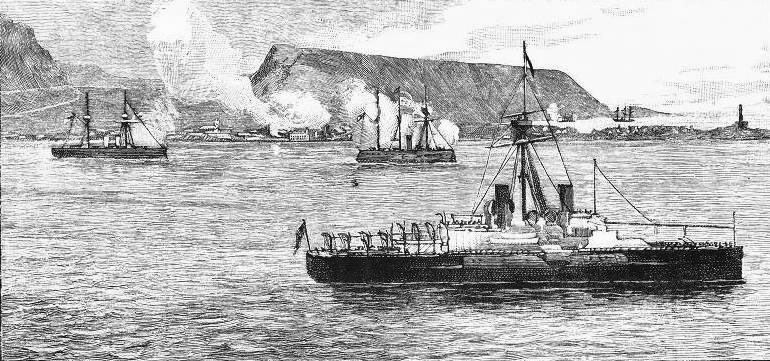
Bombardment of Iquique
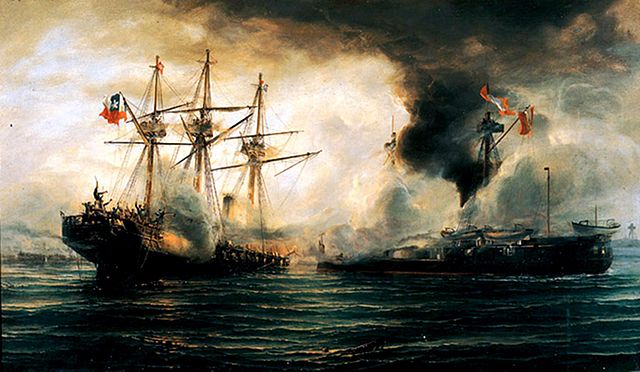
Battle of Iquique, sinking of the Esmeralda
For 137 days afterwards, Huáscar managed to both evade confrontation while following orders from the Peruvian government rampaging the Chilean coast, preying on transport ships. Her biggest prize was the Chilean gunned transport Rímac with the full cavalry regiment “Carabineers of Yungay” 260 men, horses and equipments. Nevertheless, the Chilean Government was dead set a an invasion of Peru and wanted to secure its supply lines whatever the cost. They committed every possible unit to hunt down the Peruvian “ghost ship”. On 8 October 1879 at last, after a surprise boarding, Huáscar was captured by the Chilean Navy under command of Galvarino Riveros Cárdenas at the Battle of Angamos. In this episode, the crew fiercely resisted and both Rear Admiral Grau and 32 of his most faithful followers of the crew were killed. The rest surrendered.

Battle of Angamos
With the Chilean Navy
War of the Pacific: Arica
After the Battle of Angamos, Huáscar entered service with the Chilean Navy and was sent in Arica to duel with the older Peruvian monitor Manco Cápac, making short work of her. Afterwards, she took part in the shelling of the city under of Manuel Thomson, later killed. She also took part later in the blockade of Callao. Peru lost this war. Nothing much happened the following years but it was recoignised the old ironclad was no longer relevant, and between 1885 and 1887, she was completely rebuilt and modernized in drydock in Chile. She had her steam engine and boilers replaced, a new propeller screw design installed, and new steam lines and hydraulics to power the main turrets.
In May 1888, as part of a ceremonial division commanded by Rear Admiral Luis Uribe, Huáscar brought back home Esmeralda’s officers bodies from their graves at Iquique, to a new burial in Valparaíso, given a national fallen hero’s welcome. The ceremony was presided by Rear Admiral Uribe, former executive officer aboard Esmeralda in this battle.
Chilean Civil War
Huáscar participated in the 1891 Chilean Civil War, between government and congress. When it broke out she was under maintenance and seized by the rebels, towed out of Valparaíso, readied for action against the loyalists under Command of Captain José María Santa Cruz. She took part in the takeover of Taltal and spent some days escorting convoys, protecting rebel-held ports. She was only back to Iquique to shell the government-held port. In all she spent eight months in continuous operations, until the fall of government’s forces.
Postwar years

Huáscar despite her age continued to serve the Chilean Navy, until a boiler explosion in 1897, while anchored in the Talcahuano military harbour. Due to her poor condition at the time, and long service, it was consider wise to have her decommissioned, but she was at least partially repaired, used as floating barracks in the 1900s, and became a submarine tender from 1917 to 1930.
In the early 1930s, Huáscar was considered such a national treasure, that she was reconditioned for service, this time with a new armament.

Huascar in the early 1920s
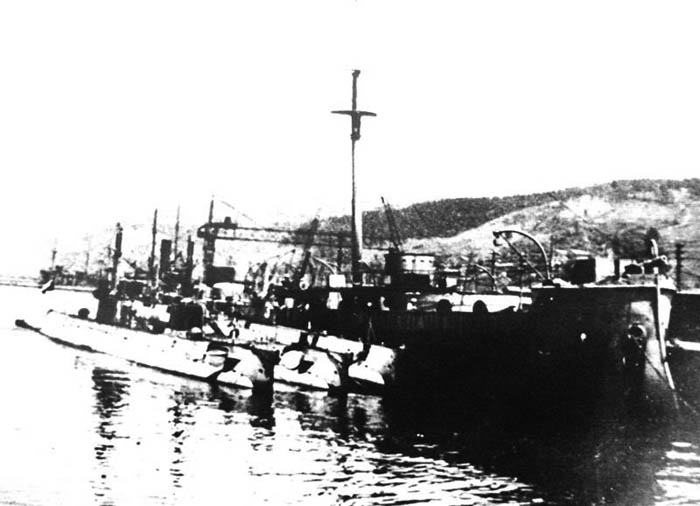
As a submarine tender in 1929-30
She was restored and recommissioned in 1934, with two more modern 8-inch guns, three 4.7 inch guns and four 47 mm guns to serve as semi-active flagship in case of war. She was moved to Talcahuano and survived WW2. By 1949 she was listed in Jane’s Fighting Ships as a “active coast defense ship” but her last photo showed her as she was in 1938. At the missile age, such a relic had little meaning as a surface combatant and thoughts were given for her preservation.
Preservation as memorial ship

Huáscar anchored in the harbour at Talcahuano and painted in Victorian-era colours, 27 July 2005
Decision was taken in 1950 to presrve her, and between 1951 and 1952, she was restored her to her 1897 state in the Chilean Navy. She was one of the rare museulm ships in the Americas and certainly the only one of her generation to be preserved outside the British HMS Warrior.
As a symbol of reconciliation with Peru, she was considered a bi-national treasure, an homage to the glory of both the Peruvian and Chilean navies.
As a floating museum and a memorial she also housed all objects and relics recovered from Navy warehouses or donated by private citizens between Talcahuano and Concepción area.

Closeup of her turret and CT
Between 1971 and 1972, she was restored again in the drydock of Talcahuan. Her hull was patched, repaired, repainted anew, and the restoration pushed further as her original engines were rebuilt according from blueprints obtained in England. There is a strict maintenance program to ensure this preservation for future generations.
In 1995, due to the care she received, the World Ship Trust awarded her the Maritime Heritage medal, handed to the Chilean Navy for its restoration. Huáscar is now berthed Talcahuano, still drawing tens of thousands of visiters each years. The great 2010 earthquake and tsunami did not damaged Huáscar. After a quick restoration, she reopened to the public in March 2011.
Read More
Books
Links
http://www.geocities.ws/barcosdelperu/ironclad-huascar.html
http://www.geocities.ws/almirantegrau/ironclad-huascar.html
https://es.wikipedia.org/wiki/Monitor_Hu%C3%A1scar
https://en.wikipedia.org/wiki/Hu%C3%A1scar_(ironclad)
Videos
Huascar by Drachinifel

 Latest Facebook Entry -
Latest Facebook Entry -  X(Tweeter) Naval Encyclopedia's deck archive
X(Tweeter) Naval Encyclopedia's deck archive Instagram (@navalencyc)
Instagram (@navalencyc)





 French Navy
French Navy Royal Navy
Royal Navy Russian Navy
Russian Navy Armada Espanola
Armada Espanola Austrian Navy
Austrian Navy K.u.K. Kriegsmarine
K.u.K. Kriegsmarine Dansk Marine
Dansk Marine Nautiko Hellenon
Nautiko Hellenon Koninklije Marine 1870
Koninklije Marine 1870 Marinha do Brasil
Marinha do Brasil Osmanlı Donanması
Osmanlı Donanması Marina Do Peru
Marina Do Peru Marinha do Portugal
Marinha do Portugal Regia Marina 1870
Regia Marina 1870 Nihhon Kaigun 1870
Nihhon Kaigun 1870 Preußische Marine 1870
Preußische Marine 1870 Russkiy Flot 1870
Russkiy Flot 1870 Svenska marinen
Svenska marinen Søværnet
Søværnet Union Navy
Union Navy Confederate Navy
Confederate Navy Armada de Argentina
Armada de Argentina Imperial Chinese Navy
Imperial Chinese Navy Marinha do Portugal
Marinha do Portugal Mexico
Mexico Kaiserliche Marine
Kaiserliche Marine 1898 US Navy
1898 US Navy Sovietskiy Flot
Sovietskiy Flot Royal Canadian Navy
Royal Canadian Navy Royal Australian Navy
Royal Australian Navy RNZN Fleet
RNZN Fleet Chinese Navy 1937
Chinese Navy 1937 Kriegsmarine
Kriegsmarine Chilean Navy
Chilean Navy Danish Navy
Danish Navy Finnish Navy
Finnish Navy Hellenic Navy
Hellenic Navy Polish Navy
Polish Navy Romanian Navy
Romanian Navy Turkish Navy
Turkish Navy Royal Yugoslav Navy
Royal Yugoslav Navy Royal Thai Navy
Royal Thai Navy Minor Navies
Minor Navies Albania
Albania Austria
Austria Belgium
Belgium Columbia
Columbia Costa Rica
Costa Rica Cuba
Cuba Czechoslovakia
Czechoslovakia Dominican Republic
Dominican Republic Haiti
Haiti Hungary
Hungary Honduras
Honduras Estonia
Estonia Iceland
Iceland Eire
Eire Equador
Equador Iran
Iran Iraq
Iraq Latvia
Latvia Liberia
Liberia Lithuania
Lithuania Mandchukuo
Mandchukuo Morocco
Morocco Nicaragua
Nicaragua Persia
Persia San Salvador
San Salvador Sarawak
Sarawak Uruguay
Uruguay Venezuela
Venezuela Zanzibar
Zanzibar Warsaw Pact Navies
Warsaw Pact Navies Bulgaria
Bulgaria Hungary
Hungary

 Bundesmarine
Bundesmarine Dutch Navy
Dutch Navy Hellenic Navy
Hellenic Navy Marina Militare
Marina Militare Yugoslav Navy
Yugoslav Navy Chinese Navy
Chinese Navy Indian Navy
Indian Navy Indonesian Navy
Indonesian Navy JMSDF
JMSDF North Korean Navy
North Korean Navy Pakistani Navy
Pakistani Navy Philippines Navy
Philippines Navy ROKN
ROKN Rep. of Singapore Navy
Rep. of Singapore Navy Taiwanese Navy
Taiwanese Navy IDF Navy
IDF Navy Saudi Navy
Saudi Navy Royal New Zealand Navy
Royal New Zealand Navy Egyptian Navy
Egyptian Navy South African Navy
South African Navy






























 Ukrainian Navy
Ukrainian Navy dbodesign
dbodesign